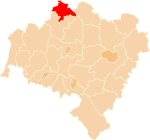Siege of Głogów
1100s in the Holy Roman Empire1109 in Europe12th century in PolandConflicts in 1109Henry V, Holy Roman Emperor ... and 3 more
History of SilesiaSieges involving PolandSieges involving the Holy Roman Empire

The siege of Głogów or Defense of Głogów (German: Schlacht bei Glogau, Polish: Obrona Głogowa) was fought on 24 August 1109 at the Silesian town of Głogów, between the Kingdom of Poland and the Holy Roman Empire. Recorded by the medieval chronicler Gallus Anonymus, it is one of the most well known battles in Polish history. The Polish forces were led by Duke Bolesław III Wrymouth, while the Imperial forces were under the command of King Henry V of Germany. Bolesław was victorious.
Excerpt from the Wikipedia article Siege of Głogów (License: CC BY-SA 3.0, Authors, Images).Siege of Głogów
Plac Kolegiacki,
Geographical coordinates (GPS) Address Nearby Places Show on map
Geographical coordinates (GPS)
| Latitude | Longitude |
|---|---|
| N 51.670555555556 ° | E 16.092777777778 ° |
Address
Plac Kolegiacki
Plac Kolegiacki
67-200 , Ostrów Tumski
Lower Silesian Voivodeship, Poland
Open on Google Maps






